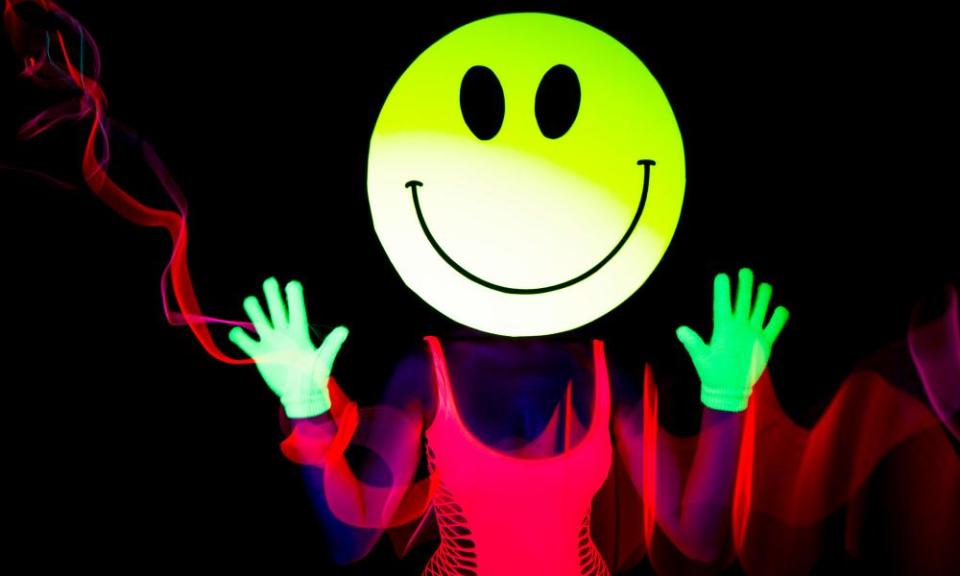It's grin out there: why have lockdown deniers co-opted the smiley face?
It was an emoji before emojis were born – an early viral image of the media age. The smiley can probably be traced back to 1960s US kids’ TV show The Funny Company but its paradoxical quality of simplistic ambiguity has made it endlessly adaptable. It’s been co-opted by Mad magazine, Nirvana, Talking Heads and the Watchmen comic series, but its most enduring usage surely began in the late 1980s when flyers for house pioneer Danny Rampling’s Shoom night in London featured the image. Before long, the smiley was on magazine covers and Top of the Pops; the beaming yellow face of a blissed-out era and a symbol of scandal, too – the implacable trickster facade of the latest tabloid moral panic.
Related: The Guide: Staying In – sign up for our home entertainment tips
Fast forward three decades and this cornerstone of acid house iconography has been reappropriated once more. The anti-facemask #SmilesMatter hashtag – which encourages mass disobedience to the wearing of face coverings in public – suggests users incorporate the image into their social media profiles. It seems part of a grim trend. Raves have been among the most visible forms of lockdown disobedience – there’s even a Twitter account, @businessteshno, that documents the considerable number of DJs who have ignored restrictions and cashed in at what have been dubbed “plague raves”. And Rampling himself has expressed support for the lockdown-sceptic Time For Recovery movement (sample tweet: “Please don’t allow our message of hope to be drowned out by the doom-mongering pro-lockdown lobby”). It would be unfair to tar all ex-ravers with the anti-lockdown brush, but this latest smiley mutation seems surprising. After all, wasn’t rave the most communitarian youth movement of them all?
Up to a point. The ethos of rave was always more ambiguous than the popular memory of pilled-up camaraderie suggests. Its apparent rejection of 80s materialism coexisted with a frontier spirit that encouraged and rewarded libertarian attitudes. Famously, Paul Staines – who later founded the influential rightwing blog Guido Fawkes – was heavily involved in the organisation of acid house parties and, as legend has it, was holding down a day job as an analyst for the Tory pressure group Committee for a Free Britain even as he was spending his weekends in various fields just off the M25. This apparent duality could be regarded as wildly contradictory or deeply appropriate. And, of course, the heady utopian bliss of the era was shadowed and often fuelled by black market ruthlessness – and not terribly many drug dealers tend to be open-hearted idealists.

Dave Swindells, the photographer who definitively documented the scene’s formative years, agrees that anti-authoritarian attitudes were both inherent to the culture and essentially unpredictable in character. “Rave and the dance scene really flourished as a result of illegal activity,” he says. “Whether that was holding illegal parties or drug use. So it goes with the territory that people should be open to a diverse and contrary range of opinions. You didn’t just go to those events to dance, but also for the social fun and games; the after-parties. What you could call alternative ideas were fundamental to the scenes which celebrated outsiders. There was an openness to unusual ideas.”
Anyone who attended raves can attest to this. Chillout zones acted as a petri dish for outlandish speculation. And, while it’s important to maintain the distinction between opposing lockdown and embracing conspiracy theories involving vaccinations, there was also a new age-inflected, Big Pharma-sceptical strand to much rave philosophy. It’s hard not to smile at the memory of some of the chemical cocktails sampled by people whose bodies are, ironically, now temples to the organic.
Most leftfield subcultures are a messy mixture of symbols and ideas. In any scene that makes a virtue of extremity, transgression is celebrated – and rave is no different. Yet an opposition to lockdown seems to jar with what was often assumed to be the underlying value system of rave. At its best, the culture was about ego-dissolution, selflessness, the buzz of the collective experience. Swindells refers to “the instant community of a dancefloor” and a sense that, in the historical context of the fall of communism and the end of apartheid, rave felt like part of a wider change. “Obviously we were naive,” he says, “but these people seem to be doing the opposite. They’re not thinking about the greater good, they’re thinking about what suits them.”
In the end, the smiley, like rave itself, contains multitudes. The symbol is easy to co-opt because it’s blank enough to mean anything to anyone. It could be unequivocally cheerful or vaguely psychotic. It could represent self-realisation or a mindless rejection of reality. Writing in the Guide in 2009, Jon Savage suggested that the Watchmen comics “used the smiley as a visual metaphor for a narrative that examines guilt, failure, megalomania and compromise with a corrupt power structure”. This paranoid vision, rather than the utopian acid house incarnation, feels suddenly much closer to the smiley’s newest usage.
Perhaps, as it has in many other areas of life, the pandemic has simply revealed already existent faultlines. Belfast duo Bicep recently spoke out against plague rave DJs, telling Mixmag that the phenomenon has “drawn a line between artists who think like businessmen and … people who are driven by creativity”. Perhaps the smiley is best compared to Pepe the Frog – the innocent online cartoon whose meaning changed and darkened after its adoption as a meme by basement-dwelling “alt-right” racists. Cartoonist Matt Furie has made attempts to reclaim the benign spirit of his creation. Maybe the rave cavalry are about to do the same?

 Yahoo News
Yahoo News 